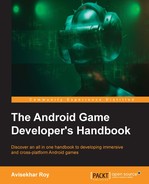Google Cardboard is a VR platform developed and released by Google in 2014 for use with a head-mounted device for a smartphone. This platform targets a low-cost project to encourage VR application development on a massive scale, which has proven to be fruitful till date. Google declared Daydream to be the next step for this platform on May 18, 2016.
The name "Cardboard" came from the concept of a VR device made with cardboard, which makes the device significantly cheaper. However, many third-party companies are following the same build architecture with various materials to increase its style and build quality.
Currently, Google Cardboard can be used to create VR applications only for Android and iOS. This has changed the VR development concept, which was limited to typical device and hardware specifications:

A typical Google Cardboard headset contains the following parts:
- A piece of cardboard cut into a precise shape
- 45 mm focal length lenses
- Magnets or capacitive tape
- A hook and loop fastener
- A rubber band
- An optional near-field communication tag
Each part of the cardboard device is either pre-fitted or has a mechanical slot to fit in. It is easy and fast to assemble the full gear. The rubber band is fitted last to wear the headset. However, holding the assembled VR headset by any means serves the purpose of a VR experience.
After assembling the kit, a compatible smartphone is inserted into the device slot of the VR headset and held in place by the corresponding components.
A Google Cardboard-compatible app splits the smartphone display image into two, one for each eye. The image can be seen through each 45mm lens. It applies barrel distortion to each display segment to counter pincushion distortion from the lenses. Thus, a complete wide 3D world is created.
Initial Cardboard headsets could fit phones with screens up to 5.7 inches (140 mm) and used magnets as input buttons, which also required a compass sensor in the smartphone device. Later, the button was replaced by a conductive lever.
Google updated the design and released the next Cardboard VR headset in 2016, which works with phones up to 6 inches (150 mm) display. It also updated the input button with a conductive lever that triggers a touch event on the smartphone's screen for better compatibility across devices.
Google allows several vendors and manufacturers to build Cardboard-compatible headsets with different materials and styles. Today, we can observe a lot of variants of this product.
